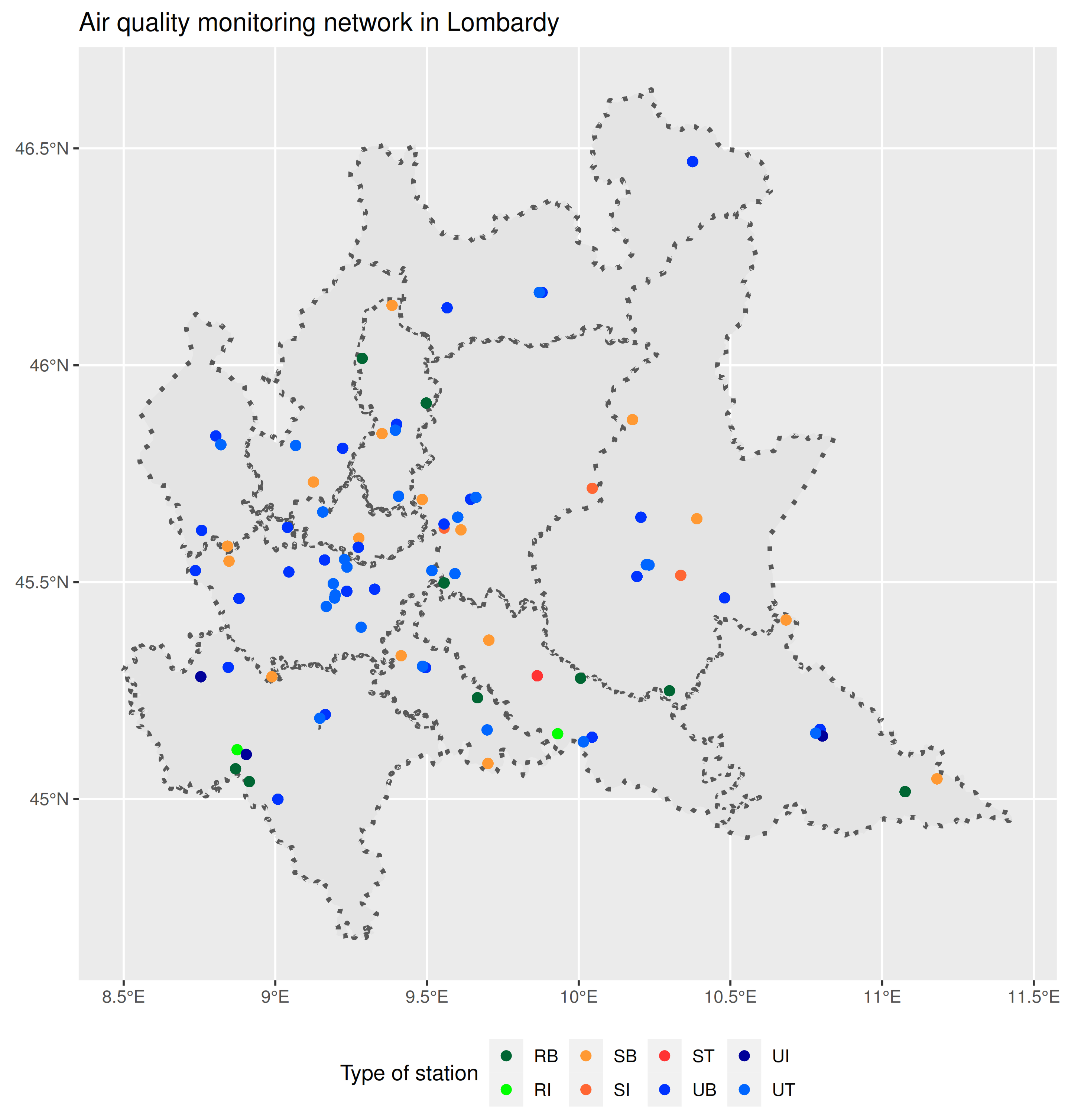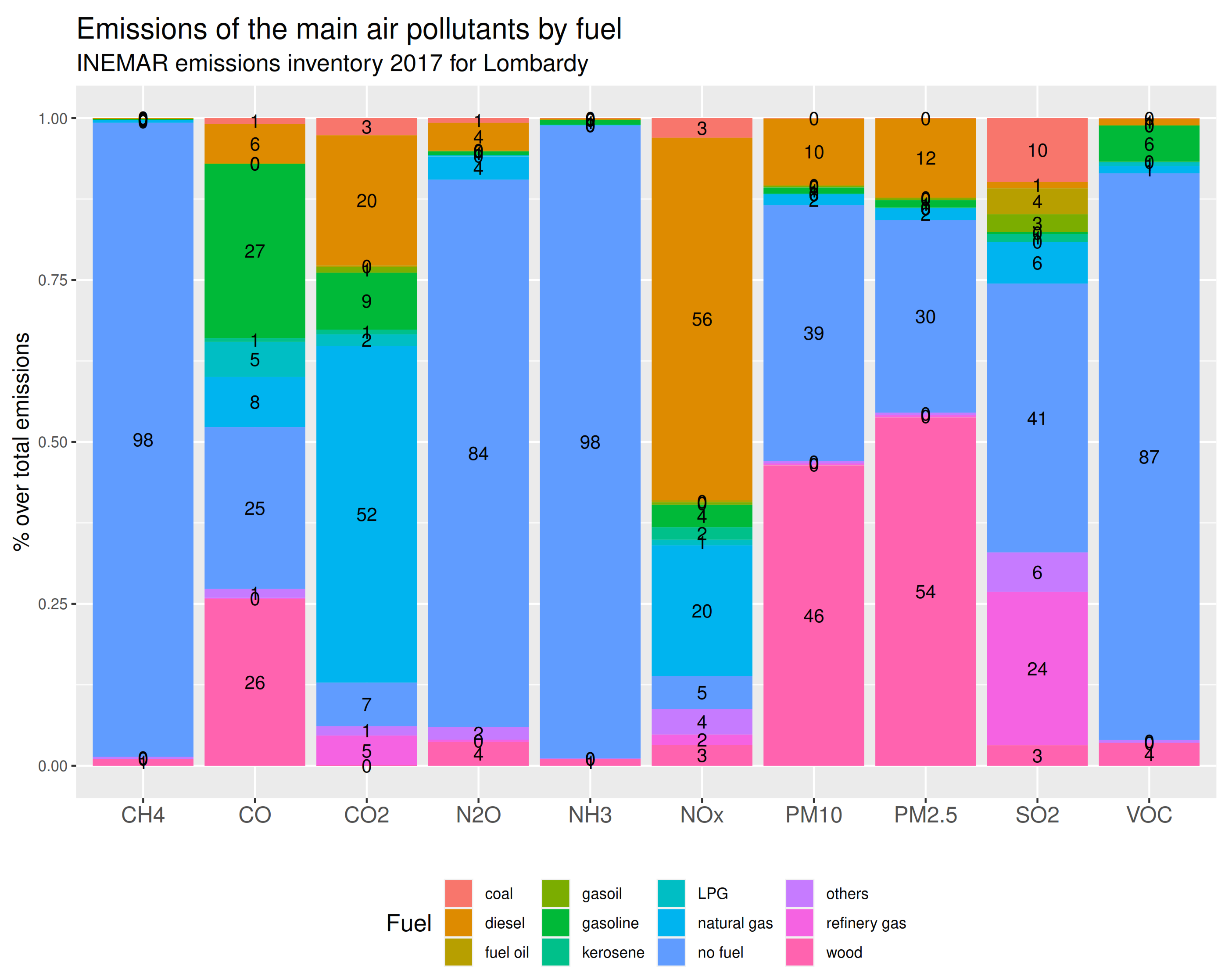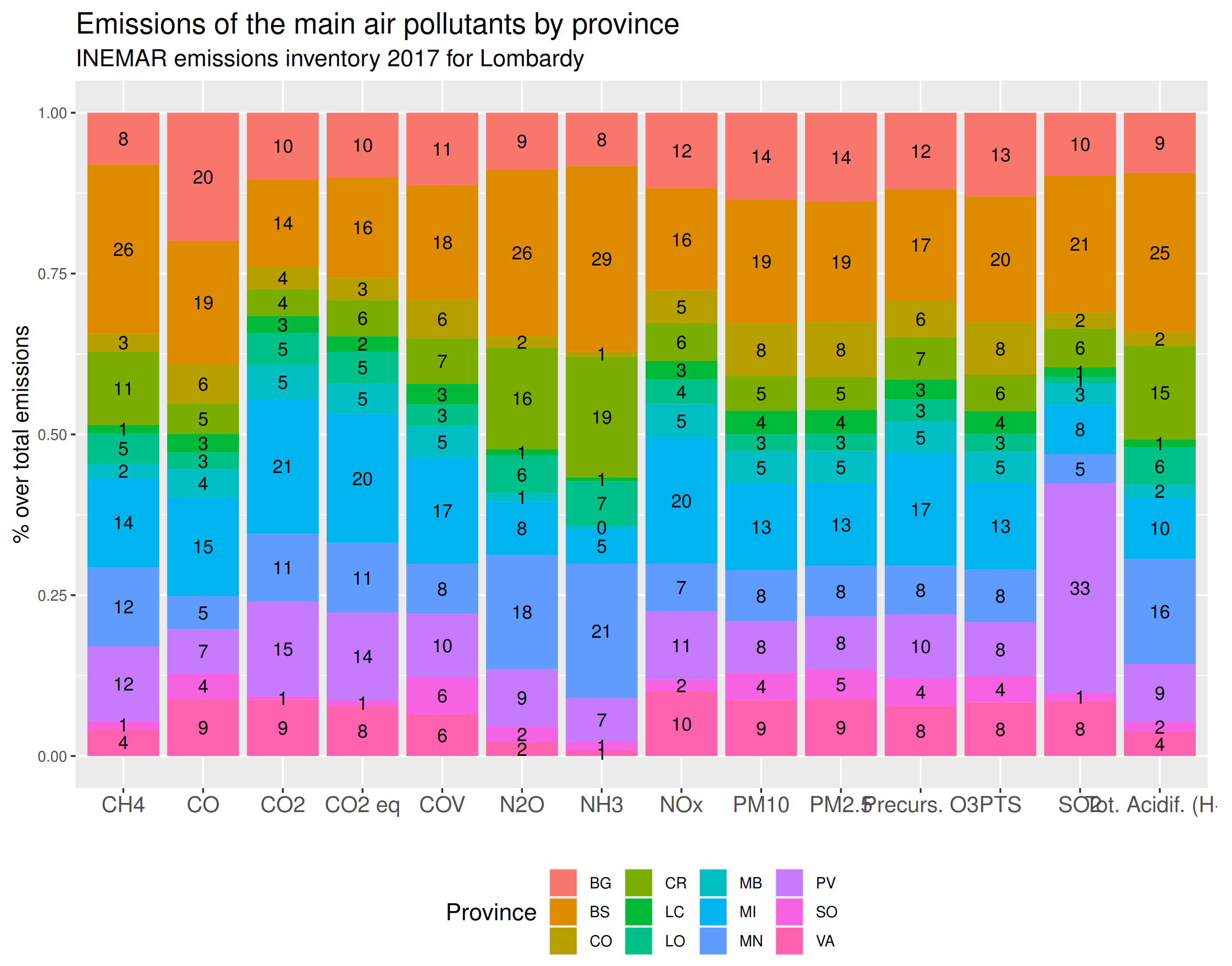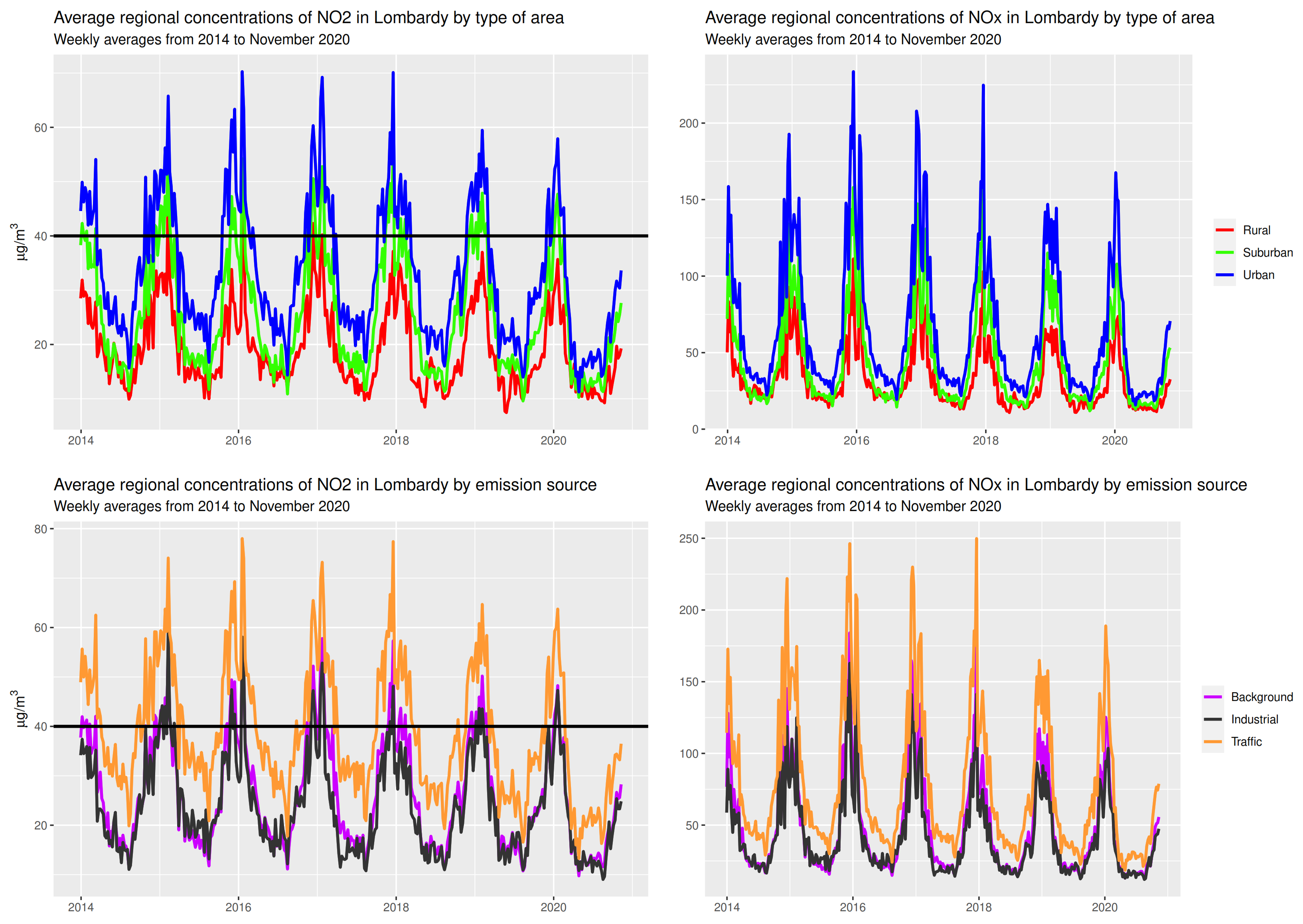5.1. Why the Lombardy Case Study Is Relevant?
For many years, Northern Italy has been at the top of the ranking of the most polluted areas in Europe [
34,
35]. The Lombardy region is the geographic and economic epicenter of this area: it is organized in 11 provinces, and it counts on more than 10 million inhabitants and the highest gross domestic product per inhabitant of Italy, approximately 35 thousand Euros per capita [
41,
42]. The air quality recorded in the Lombardy region is a case of international relevance as, despite the efforts of the authorities to counteract the phenomenon of pollution, we still struggle to comply with international rules on concentrations.
The region can be geographically and economically divided into three zones: the mountain range of the Alps at North and the Apennine at South, the sloping foothills at the Middle-North, and the highly industrialized and populated basin of the Po River in the middle. Most of its major cities are located in the Po River basin, which crosses the entire region and acts as the southern natural border for many kilometers. As shown in the left panel of
Figure 10, the Lombard basin is bordered on two sides by mountains, i.e., the southern and northern borders, which makes the atmospheric dispersion poor and which render air mass exchange very low. Wind speed measured in the Po River plain is among the lowest in Europe, about 1.5 m/s on average, causing smog and pollution trapping close to the ground. According to a recent simulation study by [
43], if Po Valley had the same meteorological conditions typical of central–northern Europe and kept the same emission levels, average monthly concentrations of PM
and NO
would be lowered by 60 to 70% and 60% compared to concentration levels of 2013. Peaks of 70–80% reduction would be reached in the western Po Valley. Consequently, it is clear that it is more difficult for Po Valley regions to comply with international air quality standards compared to other EU and non-EU member states.
Besides, Lombardy counts many industrial facilities and small and medium enterprises for which road transport is an essential component for economic viability. According to INEMAR Emission Inventory of Lombardy 2017 [
44], summarized here in
Figure 11 and
Figure 12, industrial and non-industrial combustion plants and road transport represent more than 73% of particulate matter emission sources and more than 76% of nitrogen oxides emissions in the region. Regarding oxides, carbon dioxide and particulate matters, road transport emissions diverge significantly from the European levels, with values much higher than the EU average. In particular, in the metropolitan area of Milan, which will be the subject of a specific focus in the next chapters, road traffic alone is responsible for the emission of 65% and 69% of the total emissions of NO
and CO, respectively. Coherently with their anthropogenic emissions sources, fine particulate matters are mainly generated by wood-fired heating systems (i.e., wood), while oxides are generated by chemically treated fossil fuels and petroleum derivatives (i.e., diesel and oil).
Figure 12 also reports that the large part of other airborne pollutant emissions, particularly for ammonia, volatile organic compounds and methane, are due to non-combustible materials. The two figures also highlight that emissions from agricultural activities in Lombardy are the major source of pollution regarding methane (CH4), nitrous oxide (N
O) and ammonia (NH
), for which they amount, respectively, to 58%, 87% and 97%. Regional agriculture land makes up around 69% of the total area. Lombardy is the first Italian region for agriculture production and contains 1.5 million bovines and 4 million swine, respectively, about 48% and 25% of the national headcount. The INEMAR 2017 inventory estimates that about 95% of total ammonia (NH
) emissions in Lombardy are caused by livestock and fertilizers. Indirectly, atmospheric ammonia reacts with atmospheric nitric and sulfuric acids and turns to particulate matters, generating a consequent increase in PM
concentrations [
45].
The Lombardy region is also the most densely populated country, with large and very dense urban agglomerations. The average population density in Lombardy is around 419.9 inhabitants/km
, while only 200 inhabitants/km
at national level [
41]. This fact also reflects on the spatial distribution of airborne emissions. As reported in
Figure 13, the four largest and populated provinces, i.e., Milan (MI), Monza (MB), Bergamo (BG) and Brescia (BS), generated the 52% of total emissions of NO
and the 51% of particulate matters in 2017.
Overall, its unfavorable geographical context, aggressive land use, climate characteristics and emission sources create a high level of air pollution, therefore determining long favorable periods for accumulating pollutants.
The literature concerning the evaluation of the impacts of exposure to atmospheric pollutants has given considerable space to the case of Lombardy and, more in general, to Northern Italy. Many epidemiological studies conducted using Lombardy ARPA data provided strong evidence of the association between poor air quality exposure and short-and-log term effects on health, particularly the association with mortality. Recent studies performed meta-analyses to assess how much particulate matter and oxides affect people’s health in many Lombardy locations, including Milan’s urban areas, starting from the early 2000s. In [
46], effects have been evaluated in terms of numbers of attributable deaths under some counterfactual scenarios of air pollution reduction based on WHO guidelines and European Union limits. The authors of [
46] found that current annual PM
levels are responsible for over than 13% attributable death rates per year using EU limits. By reducing existing concentrations by a fifth, it could be possible to reduce by more than 30% the burden of short-term deaths linked to ambient air pollution. Other further factors to be considered studying the Lombardy case are the transport and commuting among municipalities. In fact, mobility in Lombardy is predominant, with the highest percentage in Italy of residents commuting daily to workplaces or schools, about 5 million incoming and out-going in 2013, half of them out of their residence municipality. The authors of [
47] considered commuting data to estimate the very-short increase in mortality, i.e., within 2 days from the exposure, due to PM
in Lombardy. Their findings suggest that the largest estimated impacts are placed along the Po River basin and in the largest cities. Commuting contributes to the spatial distribution of the estimated impact. In [
48], the authors estimated the number of attributable deaths and hospital admission at the areal level through Poisson regression, showing that both NO
and PM
affect people differently based on the season and age of the patient and that to an increase of 10
g/m
in the average airborne levels is associated an increase in death rate up to 1.6%. Moreover, [
49] showed that although the average levels of particulate matter in Lombardy are progressively reducing, in all the most affected areas the population-weighted exposure levels decreased but never met the EU threshold.
Data from the open data of ARPA Lombardia are the main source used by researchers to highlight the local effects of public policies for environmental protection or to establish the ongoing atmospheric trends in the area. For example, see the studies of [
50,
51] concerning the effects of traffic restricted zones in Milan on the concentrations of air pollutants, in particular nitrogen oxides. Considering the recent events caused by the COVID-19 pandemic, first of all the travel ban between municipalities and from cities, a crucial issue is the impact of restrictions on air quality in the Po Valley. In fact, this event constituted a natural experiment of historical magnitude that enabled researchers to quantify on a global scale the effects of potential reductions or minimization of human activities on the air pollution. The literature on the subject is very wide, but consider for example the reports of ARPA Lombardia [
52] or scientific contributions such as [
8,
11,
53,
54,
55,
56].
5.2. Evidence from ARPA Lombardia Data
Using the ARPA Lombardia open database, we provide some empirical evidences about air quality and meteorology registered in Lombardy in the last few years. The objective we intend to achieve is to identify relevant short-run features of the regional atmospheric conditions using ARPA Lombardia data presented in the previous sections, as an example of how such data can be used. Specifically for weather measurements, we want to stress the fact that given the unfavorable morphology of the territory, which do not guarantee an adequate recycling of polluted air, meteorology seems to be a factor weakly able to clean the atmosphere and allow an improvement in air quality. The design and implementation of policies to reduce pollution and improve quality of life should take this into account. We recall that in this section we do not provide model-based statistical findings, but purely an empirical snapshot that captures some specific features and their short-term dynamics.
The data we will show focus on the short-run behavior of airborne pollutants and meteorology observed at aggregate level in Lombardy from January 2014 to November 2020. Regarding pollution, we analyze the measurements of oxides (NO and NO), particulate matters (PM and PM) and ozone concentrations at weekly frequency, characterizing them with respect to the geography, the type of area (urban against rural area) and by emission sources. Meteorology will be analyzed at the aggregate regional level and typifying it with respect to the installed monitoring network. All the data presented have been collected through the R package ARPALData available from CRAN repository.
Figure 14 shows the weekly mean concentrations of the four pollutants recorded in Lombardy from January 2014 to November 2020. The regional mean is enhanced by 95% Gaussian confidence limits. Mean and standard errors have been obtained by aggregating weekly observations from all available stations active on the territory during the period. The seasonal behavior of the series is well defined: oxide and particulate concentrations reach maximum peaks during winter, while their minimum is reached in summer months; on the contrary, ozone is a summer pollutant that reaches severe levels in August and minimums during winters.
Regarding oxide concentrations, both NO and NO show significant reductions in the maximum values observed, especially at the apex of winter, supporting the hypothesis of a generalized decreasing trend. Despite this, during the winter period, nitrogen dioxide concentrations show average values above the EU annual limit, which amounts to 40 g/m. The graph also reveals a similar pattern for particulate matters, defined by a period of very high concentrations between 2015 and 2018, and strong reductions in 2019 and 2020.
Figure 15 reports the weekly average concentrations for NO
, NO
, PM
and PM
according to the provinces in which they are recorded. Regarding oxide concentrations, the provinces of Monza-Brianza (MB), Milan (MI), Sondrio (SO) and Mantova (MN) are clearly identifiable and present very distant, and antithetical patterns. The first two provinces show predominant concentration levels compared to the others, being almost always above all the other provinces; whereas the last two always have the lowest values recorded. Considering a generic timestamp, the difference between the observed values of NO
is stably in the range of 40–50
g/m
. As said in
Section 3, oxides are mainly generated by anthropogenic sources, in particular by combustion processes. The areas of Milan and Monza are rich in manufacturing and industrial activities, as well as being densely urbanized. Sondrio is an alpine province with only mountains, while Mantova is a large and flat area with several rivers and agricultural land. Both areas are sparsely populated. In terms of PM
and PM
, the plot is more complex but still provides some important hints. None of the provinces seem to exceed the others, but Sondrio once again exhibits the lowest concentrations. Cremona (CR), Mantova (MN) and Pavia (PV) record very high amounts of PM
in the air during the winter months, and in some cases, as in 2016, they reach or exceed Milan (MI) or Monza-Brianza (MB). This may be due to the triangular relationship between agricultural activities, ammonia emissions, and PM
. Intensive agriculture generates high levels of ammonia, which is transformed into ultrafine particulate matter, increasing concentrations. Livelli al di sopra dei limiti.
Figure 16 and
Figure 17 report the average weekly measurements of NO
, NO
classified by area type and emission sources. Both figures clearly show that the observed concentrations are strongly dependent on the type of station, and thus on the area surrounding the monitoring site. This is particularly true for oxide concentrations. At first, for both total oxides and nitrogen dioxide the urban and traffic stations record values well above the other types throughout the period considered. Their spring and summer readings are around 25–30
g/m
, while in the winter months they reach levels of 65–70
g/m
(well above the permitted legal limits). Rural stations have values permanently below 40
g/m
. Background stations stand reasonably in the middle, because of their purpose of monitoring sites not directly adjacent to emission sources. In contrast, fine and ultrafine substances do not appear to be affected by station classification and show homogeneous concentrations. Taking as reference the EU daily limits, i.e., 50
g/m
for PM
and 25
g/m
for PM
, concentrations seem out of control during winter and under control during the rest of the year. The data show that as of 2019, particulate matter has experienced large reductions compared to 2016–2018, but there is still great potential for improvement.
As preliminary observational results, it is possible to state, in line with what reported by the European Environment Agency, that Lombardy suffers from concentrations well above the allowed limits for almost all pollutants considered, especially in winter periods, and needs immediate interventions on the production structure and mobility.
Lombardy is subject to a continental climate, characterized by warm and humid summers and cold winters. During anticyclonic episodes, the region experiences higher concentrations of atmospheric aerosols, persistent fog and haze [
57]. Meteorology is considered a key factor in monitoring air quality data, especially because ignoring the relationship between weather and pollutants would inevitably lead to biased estimates of concentrations and even underestimates [
8,
51,
58]. The Po basin, in particular the Lombardy region, enjoys an unfavorable microclimate that generates large accumulations and pockets of pollutants. The presence of the Alps to the north and the Apennine chain to the south (
Figure 10) heavily inhibits wind circulation.
Figure 17.
Average weekly concentrations of particulate matters by type of area (rural, urban or suburban) and by type of emission source (traffic, background or industrial) in Lombardy. Horizontal lines are the EU daily average limit. Upper left panel: average weekly concentrations of PM by type of area; lower left panel: average weekly concentrations of PM by emission source; upper right panel: average weekly concentrations of PM by type of area; lower right panel: average weekly concentrations of PM by emission source.
Figure 17.
Average weekly concentrations of particulate matters by type of area (rural, urban or suburban) and by type of emission source (traffic, background or industrial) in Lombardy. Horizontal lines are the EU daily average limit. Upper left panel: average weekly concentrations of PM by type of area; lower left panel: average weekly concentrations of PM by emission source; upper right panel: average weekly concentrations of PM by type of area; lower right panel: average weekly concentrations of PM by emission source.
Using the data available from the open data of ARPA Lombardia, it is possible to obtain an intuitive insight about the meteorological situation in the region. The wind speed is poor and does not allow the recycling and cleaning of the air. This situation is well described in the
Figure 18, which distinguishes the wind in the region.
The average hourly wind speed registered is very low, most of the records are well below 2 m/s and never above 7 m/s, consistently with the findings of other studies such as [
59,
60,
61]. This fact is also confirmed in
Figure 19, which shows the average (left panel) and maximum (right panel) wind speed measured at each monitoring location of the ARPA Lombardia network. Looking at the mean speed, the highest values are associated with stations in the Alps chain (North) or in the Appennini chain (South). However, the average value never exceeds 5 m/s. Instead, wind gusts can reach values over 75 m/s, once again in the mountainous areas. The distribution of wind direction (upper panels of
Figure 18) shows that the wind blows mainly from the North (high concentration of cases around 0
and 360
) with some reduced peaks from the East (values in the 80
to 100
range). During the year, it is possible to notice some heterogeneity between the seasons. For example, in the winter months (December–February) the main wind comes from the north and has a higher speed than the rest of the year, while between spring and summer, the wind increases from the south and east.
Another relevant factor for air cleaning is the rainfall, here reported by
Figure 20. Precipitation also seems to discourage air cleaning. The Lombardy region records a modest amount of water precipitation, almost always less than 5 mm daily total. A slight variability of rainfall is recorded during the year: in the coldest winter months (December–January), rainfall of less than 2 mm daily is recorded for almost the whole month, while in May, August and November, the highest rainfall is recorded. Spatial variability of rainfall is another phenomenon to consider. As discussed by [
62], in Northern Italy the distribution of annual precipitation among the plain and the mountains deeply changed over time, with an increase of the precipitation at the high elevations compared to the low elevations starting in the mid-20th century and peaking in the 1980s. The latter fact is also confirmed in our data by
Figure 21, which reports the average rainfall observed during May (left panel) and the average rainfall observed across the whole year (right panel) for each monitoring site of the ARPA Lombardia network. By averaging the entire period, which looks uniform over the territory, we confirm what we stated earlier, namely that the amount of rain is very low, almost systematically less than 2
. If we consider the rainiest month, i.e., May, the spatial heterogeneity is emphasized: on the mountain range (North) we reach rainfall of more than 8
, while in the southern plain rainfall remains very scarce.
Finally, we move on to regional temperature patterns. Specifically, we report the average, minimum and maximum weekly temperatures recorded across the region from 2016 to November 2020 (
Figure 22) and the average weekly temperature by province (
Figure 23).
The key message that both figures highlight is that in the last years, the temperature recorded in Lombardy is increasing, both the minimum and the maximum. This is evidenced by the clear increasing linear trend superimposed on the observed temperatures. In particular, the regional minimum temperature (blue line in the
Figure 22) is rapidly increasing: in January 2016, the minimum temperature was around 3°, while at the end of 2019, it stabilized between 5 and 6° Celsius, recording the highest minimum temperature of the period under study. The observed increases in average temperature are also visible at the provincial level. All provinces recorded higher average temperatures in 2019 and 2020 than in previous years. Interestingly, the province of Sondrio (light blue line in
Figure 23), located in the far north of the region and bordering Switzerland, recorded values around zero in early 2019, while during the same period in 2016 or 2017, the temperature was well below zero.
The period considered to derive the preceding evidences is too short to establish long-term connections and/or causal relationships related to climate change in the region. However, even in the short term, it is evident that something is quickly changing in the anthropogenic impact on local Lombardy quality. The decreasing trends in oxides concentrations recorded after 2016, reaching minimum levels in 2020, could be influenced by consistent improvements in citizens’ vehicle fleets, with a wider use of carbon-neutral vehicles, or changes in the industrial productive system, more careful to the territory and to the control of emissions.





























